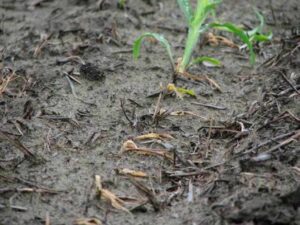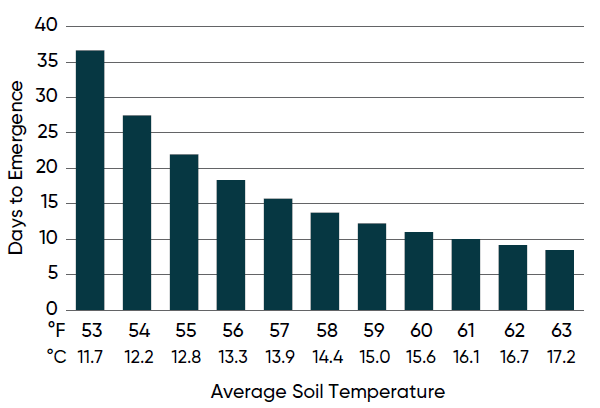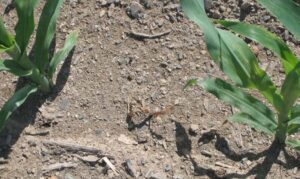Seed and Seedling Diseases

A corn plant infected with seedling disease. This field experienced cold conditions and saturated soils after planting.
Corn fields can contain numerous pathogens in the soil that are capable of infecting corn seeds and seedlings. Corn planted into a well-prepared seedbed with warm conditions that allow it to emerge quickly, can generally outgrow the effects of pathogen attack. However, corn planted into cold, wet soils that emerges more slowly can be susceptible to injury from soilborne pathogens. Soilborne pathogens may attack seeds and seedlings both before and after plant emergence, as well as the roots and mesocotyl of emerging or established plants.
The effect of soil-borne diseases on stand establishment and plant development depends largely on the duration of adverse weather and the prevalence of other factors that affect overall plant health, emergence, and early growth. Soil compaction, heavy crop residues, crusting, herbicide or fertilizer injury, and excessive planting depth can all weaken the plant, delay emergence, and increase the susceptibility of corn seedlings to diseases.
Conditions that Favor Disease
The ideal environment for most soilborne diseases that attack corn seeds and seedlings is wet and cool (50-60ºF, 10-16ºC). Under these conditions, corn develops very slowly. For example, when the soil temperature averages only 55ºF (13ºC), corn seedlings require over 20 days to emerge. Fungicide seed treatments applied at label rates to protect the seed during germination and emergence can provide protection for six weeks after planting. However, extended delays in emergence can stretch the limits of fungicide seed treatments and makes seeds vulnerable to attack. Soil temperature during emergence is determined by geography, soil type, soil moisture, residue cover, tillage, planting date and weather patterns.
Weather conditions are the most important determinant of growing environment in any year. Cold, wet conditions that favor seed and seedling disease development will occur periodically in all fields and frequently in some fields. The amount of inoculum in the soil also affects disease development. Soilborne pathogens that attack corn seedlings survive in both corn residue and in the soil. They are both saprophytic and parasitic, able to attack dead and living plant tissue. Pathogens have alternative hosts, sometimes including previous crops and weeds – both corn residue and that of other crops and weeds can be important to inoculum load. If a field has a history of seedling disease problems, inoculum load is likely to be high. Knowing the history of each field with respect to problem areas and related causes is important to successful management of seedling diseases.
Common Pathogens

Table 1. Symptoms and favorable environmental conditions for the most common pathogens affecting corn seedlings. (Click to expand.)
Soil-inhabiting disease organisms that attack corn seeds and seedlings include Pythium, Fusarium, Rhizoctonia, Penicillium, Colletotrichum, Diplodia, and others (Table 1). Each of these fungal genera includes multiple species capable of infecting corn that can differ in pathogenicity and environmental influences.
Pythium, a water mold that survives in soil and plant debris, is an otherwise weak pathogen that tends to predominate under very wet soil conditions. This is because high soil moisture levels promote germination of the overwintering oospores. Soil water also provides a medium for the swimming of zoospores, the germinated motile spores that infect the corn root system. Pythium is one of the first groups of fungi to attack corn in the spring, due to the low temperature optimum of some species. Cool soil temperatures of 50-60°F (10-16ºC) favor several Pythium species that are common in northern areas, particularly in early-planted fields, but the various species of Pythium are active over a wide range of temperatures.
Other seedling pathogens like Fusarium and Rhizoctonia do not require extremely wet conditions in order to cause disease. Fusarium is a ubiquitous soil-borne group of fungi that can be found to some degree on the majority of corn plants suffering from seedling diseases. Rhizoctonia is another very prevalent fungal group with a wide range of plant hosts.
When a corn plant succumbs to seedling disease, multiple pathogens are usually involved. Dying seed or seedling tissues below ground are rapidly colonized by a variety of fungi, all of which contribute to the decay, making it difficult to determine the primary pathogen. Consequently, it is useful to think of corn seedling disease as a complex of fungi that must be controlled as a group. Management strategies to reduce the risk of injury from soilborne pathogens are largely the same, regardless of the pathogen involved.
Diagnosing Seedling Diseases
Field Level Symptoms
At the field level, seedling disease may be slight to severe. Early symptoms of slow growth, chlorosis, stunting, and missing plants may be followed by near complete recovery if favorable conditions allow corn to outgrow the injury. But if cold, wet conditions continue, symptoms often worsen and stands decline. Missing plants may be in patches or scattered among other plants. Often, a chlorotic, stunted plant will appear next to a healthy one (Figure 1). Symptoms may be more noticeable in low-lying areas of the field. These are not typical symptoms associated with other seedling problems such as fertilizer or herbicide injury, nutrient deficiency, or restricted growth due to compaction or crusting.
In extreme cases, replanting the entire field or affected field areas may be necessary. Even when replanting is not required, diseased fields may have reduced yields due to low plant population, uneven plant growth, and reduced plant health and fitness. Stunted plants surrounded by healthy plants may be uncompetitive and fail to produce an ear. Rotted roots seldom recover entirely, resulting in plants that are less able to withstand later stresses such as drought, storms, insect feeding, and stalk rot development.
Seed and Plant Symptoms
Soilborne pathogens may attack seeds and seedlings both before and after plant emergence, as well as the roots and mesocotyl of emerging or established plants.
Seeds: In some cases, seeds may rot prior to germination. Affected seeds are often soft, discolored, and overgrown with fungi. Rotted seeds decompose very rapidly and may be difficult to find. Soil adhering tightly to the decomposing seed may help to obscure it.
Pre-emerged seedlings: Oftentimes, the seed germinates but the seedling is killed before it emerges from the soil. The coleoptile and primary roots may be discolored and have a wet, rotted appearance.
Post-emerged seedlings: Seedlings may emerge through the soil surface before developing symptoms. Plants affected at this stage may grow more slowly than surrounding, healthy plants and appear chlorotic (yellow), stunted or wilted. In severe cases, damping off of seedlings may occur. Damping off generally refers to rapid wilting and death of seedlings as soft rot collapses the stem, often at the soil line. Pythium and Fusarium are the most common fungi associated with seed rot and damping off of corn.
Roots and mesocotyl: Discolored, sunken lesions may be evident on the mesocotyl, which eventually becomes soft and water soaked. The root system is usually poorly developed and discolored, and water-soaked roots may slough off. If the primary root system and mesocotyl are severely affected before the nodal or permanent root system has developed, the plants have little chance of survival.
For further diagnosis of plants with aboveground symptoms, carefully dig up living plants, wash the soil from the roots, and look for rotted tissue and discolored lesions on the plant stem, crown, and roots. Discoloration may range from whitish pink to gray, to dark brown or black, or even greenish blue, depending on the array of pathogens involved.
Distinguishing Seedling Diseases

Several corn plants in a row dead from seedling disease in a
field that experienced cold and wet conditions after planting.
Subtle differences exist between the various soil fungi that attack corn seeds and seedlings. For example, Pythium thrives in cool, wet soils and is among the first plant pathogens active in the spring. In spite of subtle differences, it is difficult or impossible to distinguish these pathogens based on symptoms alone. Many symptoms are similar, and more than one fungus invariably attacks the plant. Distinguishing among pathogens has little value anyway, as management practices are similar across soil diseases. The important distinction is between diseases and other seedling problems, including insect feeding, fertilizer or herbicide injury, or restricted growth due to compaction or crusting.
Reducing the Risk of Seedling Disease
Managing corn seedling diseases begins with an effective fungicide seed treatment package. Additionally, growers can help to minimize the effects of seedling diseases by avoiding planting when soil temperatures are likely to remain low for an extended period of time. Management practices that minimize soil compaction, crusting, dense crop residue over the row, herbicide injury, or fertilizer injury will help maintain seedling health and reduce susceptibility to soilborne pathogens.
Seed Treatments

Table 2. Activity of the fungicide components of the LumiGEN® seed treatment package on corn products against primary corn seedling diseases. (Click to expand.)
The LumiGEN® fungicide seed treatment package on corn products includes five different active ingredients, providing multiple modes of action against each of the three primary seedling disease pathogens, Pythium, Fusarium, and Rhizoctonia (Table 2).
Like all pesticides, seed-applied fungicides break down in the soil. Applied at label rates, these products can provide protection against seedling diseases for six weeks after planting. The benefits of this early protection can extend all season though, as the establishment of a strong and healthy root system can make the plant better able to fend off pathogens later in the season.
Insecticide seed treatments have no direct activity against diseases but may contribute to disease control in a secondary way. By reducing insect feeding on roots and plants, insecticide seed treatments reduce the points of entry into the seedling by pathogenic fungi.
Soil Temperature at Planting
Most soil-borne pathogens are ineffective against a treated corn seed and a healthy, growing corn seedling. But at soil temperatures below 55°F (13°C), corn germination and emergence require three weeks or more (Figure 2). During this time in the soil, the corn seed and seedling are vulnerable to a myriad of stresses that can weaken the plant and increase its susceptibility to seedling diseases that often thrive in cool, wet conditions. Primary stresses include excessive herbicide uptake, fertilizer burn, and insect feeding.

Figure 2. Estimated days to corn emergence by average soil temperature, based on 110 GDUs to emergence. (Click to expand.)
Growers should begin their corn planting in fields with lighter soils, good drainage, and minimum residue over the row. In heavy-textured, low-lying, or high-residue fields, especially those with a history of seedling diseases, early planting in cold soils is not recommended. Generally, growers should wait until soil temperatures rise above 50°F (10°C) and are likely to remain there before planting corn in those fields.
Residue Management
A seedbed that is well-drained with little or no crop residue over the row will reduce the risk of corn seedling diseases. Compaction, crusting and dense residue in the row are barriers to seedling emergence and are often a primary contributor to seedling disease development.
Cover Crop Systems

Corn growing in killed rye stubble. Rye can serve as a green bridge for soilborne pathogens that attack corn seedlings.
Corn planted following a rye cover crop can be at greater risk of seedling disease, as rye can serve as an alternate host for soilborne pathogens that attack corn. Soilborne pathogen populations that would normally decline during the fallow period over the winter when no host crop is present are instead sustained by the rye cover crop. When the rye is terminated, the dying roots release pathogens back into the soil. Corn planted before or immediately following termination can consequently be subject to a higher inoculum load. Iowa State University pathologists recommend waiting at least 10-14 days to plant corn following termination of a rye cover crop to reduce the risk of corn seedling diseases.
Courtesy of Mark Jeschke, Ph.D., Agronomy Manager, Corteva Agriscience.
Butzen, S., and G. Munkvold. 2004. Corn Seedling Diseases. Crop Insights. Vol 14, No. 14. Pioneer. Johnston, IA.
Vittetoe, R. 2018. Cover Crops, Corn and Seedling Diseases. Prairie Farmer. https://www.farmprogress.com/crop-disease/cover-crops-corn-andseedling-diseases

